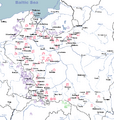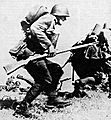Invasion of Poland (1939) facts for kids
Quick facts for kids Invasion of Poland (1939) |
|||||||||
|---|---|---|---|---|---|---|---|---|---|
| Part of World War II | |||||||||
 The map shows the beginning of the Second World War in September 1939 in a wider European context. |
|||||||||
|
|||||||||
| Belligerents | |||||||||
|
|
|||||||||
| Commanders and leaders | |||||||||
|
(Ukrainian Front) |
|||||||||
| Strength | |||||||||
|
Germany: Total: 1,500,000 Germans, 466,516 Soviets, 51,306 Slovaks Grand total: 2,000,000+ |
Poland: 39 divisions (some of them were never fully mobilized and concentrated), 16 brigades, 4,300 guns, 880 tanks, 400 aircraft Total: 950,000 |
||||||||
| Casualties and losses | |||||||||
|
Germany: USSR: 1,475 killed or missing, 2,383 wounded |
Poland: 66,000 dead, 133,700 wounded, 694,000 captured |
||||||||
The Invasion of Poland in 1939 was a military offensive in which Nazi Germany, and two weeks later the Soviet Union, invaded Poland. It was the start of World War II in Europe. The invasion took place from 1 September to 6 October 1939. The invasion of Poland caused Britain and France to declare war on Germany on 3 September; they did little to affect the September Campaign. In the end, Poland lost. Germany and the Soviet Union divided the country according to a treaty signed years before the war.
This was often called the first time blitzkrieg was tried on the battlefield, though similar methods had been used earlier. The German surprise attack was successful. It was very effective against the ineffective and unmobilized Polish Army, whose tanks and airplanes were few and mostly old. They were outflanked, outmaneuvered, and outnumbered in September 1939, and easily destroyed by the blitzkrieg. The Poles if well prepared could have had two million soldiers in the fight.
In the first few days of the German invasion the Poles proved to be more difficult than the Germans expected. In the Battle of Mokra on September 2nd, the Poles repulsed an attack by a German Panzer division forcing their retreat. The German air force, unlike their invasions of other countries, did not easily overcome the outnumbered Polish Air Force. However, due to their great superiority in numbers they gained air superiority after 5 to 6 days.
Surrounded by German territories north, west and south of Poland, the Poles had little space for tactical retreat. The Germans reached Warsaw and attacked on September 7 but were repulsed suffering heavy tank losses and were forced to retreat. The Battle of Bzura on September 9 was the largest attack by the Poles during the war. The Poles had great initial success decimating 2 German divisions and took 3500 German prisoners. Polish infantry fought well, but by September 19th due to overwhelming German reinforcements were defeated.
When the Poles realized the British and French were in a phoney war and had no intention of assisting Poland and especially when the Red Army invaded Poland from the east on September 17th, the Polish high command ordered as many troops and equipment to the Romanian bridgehead to enter Romania with the intention to continue their resistance by moving as much of their army to France as possible. Most of the Polish navy escaped to Britain. Polish cryptographers who had cracked the German Enigma (machine) went to France and later to Britain to continue their work.
Polish politicians set up a government-in-exile in France and later escaped to Britain. In 1945 when the Allied armies invaded Germany forcing their surrender, the Polish army was the fourth largest allied army.
Images for kids
-
Vyacheslav Molotov signs the Molotov–Ribbentrop Pact, a German–Soviet non-aggression pact.
-
German troops during the fighting in the streets of Warsaw
-
Disposition of all troops following the Soviet invasion.
-
Hitler attends a Wehrmacht victory parade in Warsaw on 5 October 1939
-
Polish uhlan with anti-tank rifle (Wz. 35), 1938
See also
 In Spanish: Invasión alemana de Polonia de 1939 para niños
In Spanish: Invasión alemana de Polonia de 1939 para niños
































